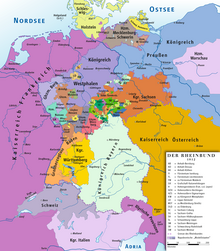Model state
As a model state referred to three West German states at the initiative of the French emperor Napoleon Bonaparte were established. Meant are the Grand Duchy of Berg with the capital Düsseldorf (1806–1813), the Kingdom of Westphalia with the capital Kassel (1807–1813) and partly the Grand Duchy of Frankfurt with the capital Aschaffenburg (1810–1813), although the latter was not expressly founded in this sense but the Principality of Aschaffenburg continued. The states reorganized areas that had disintegrated under French power politics or whose princes had been deposed. They themselves disintegrated in 1813 after the Battle of Leipzig , when Napoleon suffered his decisive defeat.
These satellite states were called model states because Napoleon did not just want the areas to be administered. You should become a model of rational state organization and radiate to other German states (especially Prussia ). They introduced the legal equality of citizens through the Civil Code , but as a rule shied away from, for example, systematically implementing the peasant liberation .
The model states presented in the theory represents excellent progress, but suffered from three basic problems, such as Helmut Berding expounded exemplifies Westphalen:
- Despite all the good intentions, Napoleon remained the French emperor and conqueror to whom the model states had to pay tribute . The obligation to provide troops for Napoleon's wars also caused social unrest .
- The model states had to support Napoleon's economic war against England (see continental blockade ) and thus lost an important trading partner. The areas suffered great economic hardship.
- Napoleon rewarded deserving generals and ministers with manors whose income the model states lacked.
The so-called subsidiary republics (especially in Italy) and the Kingdom of Holland (1806–1810) are comparable with the model states . Other parts of Germany were annexed by France at the time of the Confederation of the Rhine or by France's allies.
See also
supporting documents
- ^ Helmut Berding : The Kingdom of Westphalia as a Napoleonic model and satellite state (1807-1813). In: Gerd Dethlefs, Armin Owzar , Gisela Weiß (ed.): Model and Reality. Politics, culture and society in the Grand Duchy of Berg and in the Kingdom of Westphalia (= research on regional history. 56). Ferdinand Schöningh, Paderborn et al. 2008, ISBN 978-3-506-75747-0 , pp. 15-29, here pp. 27-28.
